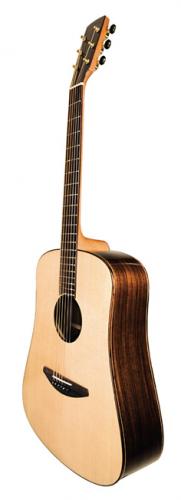Baden D-Style Acoustic Guitar


As vice president of sales and marketing at Taylor guitars, T.J. Baden helped transform that company from a small, struggling enterprise into one of the world's leading acoustic manufacturers. Now, with the help of partner Errol Antzis, a onetime investment banker and extreme guitar enthusiast, he has gone his own guitar way with a small, select line of acoustics. Baden and Antzis enlisted the service of two renowned European luthiers-Andreas Pichler and Ulrich Tueffel-and all four collaborated on the design of auditorium- and dreadnought-style instruments that are at once modern and traditional.
Baden guitars are constructed at the Ayers factory in Vietnam. Yet unlike most imports-and even high-end domestically made guitars-Badens are hand-built from start to finish, with six French master luthiers overseeing the entire operation. As a result, each guitar is unique, soulful and considerably less costly than an instrument handmade in the United States.
Like all of the company's instruments, the D-style (dreadnought) Baden is constructed entirely of solid woods: a Sitka spruce top (optional European spruce for $200), a single-piece mahogany neck and rosewood back and sides. The guitar's binding, bridge, fretboard, heel cap and headstock overlay are all made from rosewood. The lovely woods are the closest thing you'll find to adornment on this guitar; there aren't even any fretboard position makers, just some unobtrusive side dots. If you like 'em minimalist, this guitar's all you.
Some other appointments include handsome nitrocellulose lacquer on the body and headstock, and a nice satin finish on the neck. As for the smaller details, the nut and saddle are perfectly shaped by hand, and elegant, high-gear-ratio gold machines with wood buttons facilitate smooth tuning. The only exception to the guitar's Spartan appearance is a small triangular-shaped inlay embedded at the top of the soundhole.
The Baden plays very smoothly, thanks to its medium-sized C-shape neck, 25 1/2- inch scale length fretboard, 1 3/4-inch nut, impeccable fretwork and comfortable action. And it sounds awesome. Spot-on intonation insures that the guitar rings perfectly in tune from the first fret to the 21st. The bass is nice and tight, not overly boomy, and the treble, while just slightly weaker, rings clearly. The guitar has plenty of volume. Single notes sound thick and articulate, and chords in all registers sound brilliant and uncluttered. Equally suited to frenetic strumming and delicate fingerpicking, the instrument is quite responsive as well.
The review model came with optional electronics, the Fishman Ellipse Aura ($400). One of my gripes about acoustic- guitar electronics is that those with controls installed on the side of an acoustic look obtrusive and incongruous. However, in keeping with the Baden's clean design, the Fishman's onboard preamp is discretely mounted inside the soundhole. This not only works aesthetically, but also allows for easy access to the controls in playing position.
The Ellipse Aura is equipped with Fishman's Acoustic Imaging Technology, which provides lifelike, miked acoustic tone. The Images can be blended with the sound of the saddle-mounted pickup by a slider, making for a variety of excellent amplified sounds; noisiness can be suppressed with the Automatic Anti- Feedback control. I tried all four default Images and got a nice spectrum of tones without the shrillness associated with piezo pickups, and the sounds were convincing enough to be used for a solo acoustic set or any sort of ensemble setting. So, if you purchase a Baden, the Fishman option is highly recommended. With its distinctive appearance, exquisite playability and tonal versatility, the Baden is a total winner. It is perfect for any player looking for a hand-built, high-end guitar at a reasonable price, which he can enjoy for years to come.
All the latest guitar news, interviews, lessons, reviews, deals and more, direct to your inbox!
